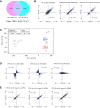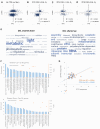Direct and indirect responses of the Arabidopsis transcriptome to an induced increase in trehalose 6-phosphate
- PMID: 38593032
- PMCID: PMC11376379
- DOI: 10.1093/plphys/kiae196
Direct and indirect responses of the Arabidopsis transcriptome to an induced increase in trehalose 6-phosphate
Abstract
Trehalose 6-phosphate (Tre6P) is an essential signal metabolite that regulates the level of sucrose, linking growth and development to the metabolic status. We hypothesized that Tre6P plays a role in mediating the regulation of gene expression by sucrose. To test this, we performed transcriptomic profiling on Arabidopsis (Arabidopsis thaliana) plants that expressed a bacterial TREHALOSE 6-PHOSPHATE SYNTHASE (TPS) under the control of an ethanol-inducible promoter. Induction led to a 4-fold rise in Tre6P levels, a concomitant decrease in sucrose, significant changes (FDR ≤ 0.05) of over 13,000 transcripts, and 2-fold or larger changes of over 5,000 transcripts. Comparison with nine published responses to sugar availability allowed some of these changes to be linked to the rise in Tre6P, while others were probably due to lower sucrose or other indirect effects. Changes linked to Tre6P included repression of photosynthesis-related gene expression and induction of many growth-related processes including ribosome biogenesis. About 500 starvation-related genes are known to be induced by SUCROSE-NON-FERMENTING-1-RELATED KINASE 1 (SnRK1). They were largely repressed by Tre6P in a manner consistent with SnRK1 inhibition by Tre6P. SnRK1 also represses many genes that are involved in biosynthesis and growth. These responded to Tre6P in a more complex manner, pointing toward Tre6P interacting with other C-signaling pathways. Additionally, elevated Tre6P modified the expression of genes encoding regulatory subunits of the SnRK1 complex and TPS class II and FCS-LIKE ZINC FINGER proteins that are thought to modulate SnRK1 function and genes involved in circadian, TARGET OF RAPAMYCIN, light, abscisic acid, and other hormone signaling.
© The Author(s) 2024. Published by Oxford University Press on behalf of American Society of Plant Biologists.
Conflict of interest statement
Conflict of interest statement. None declared.
Figures










Similar articles
-
The sucrose-trehalose 6-phosphate (Tre6P) nexus: specificity and mechanisms of sucrose signalling by Tre6P.J Exp Bot. 2014 Mar;65(4):1051-68. doi: 10.1093/jxb/ert457. Epub 2014 Jan 13. J Exp Bot. 2014. PMID: 24420566 Free PMC article.
-
Trehalose 6-phosphate coordinates organic and amino acid metabolism with carbon availability.Plant J. 2016 Feb;85(3):410-23. doi: 10.1111/tpj.13114. Plant J. 2016. PMID: 26714615
-
A Tale of Two Sugars: Trehalose 6-Phosphate and Sucrose.Plant Physiol. 2016 Sep;172(1):7-27. doi: 10.1104/pp.16.00417. Epub 2016 Aug 1. Plant Physiol. 2016. PMID: 27482078 Free PMC article. Review.
-
Impact of the SnRK1 protein kinase on sucrose homeostasis and the transcriptome during the diel cycle.Plant Physiol. 2021 Nov 3;187(3):1357-1373. doi: 10.1093/plphys/kiab350. Plant Physiol. 2021. PMID: 34618060 Free PMC article.
-
Trehalose metabolism in plants.Plant J. 2014 Aug;79(4):544-67. doi: 10.1111/tpj.12509. Epub 2014 May 21. Plant J. 2014. PMID: 24645920 Review.
Cited by
-
The synthesis, degradation and biological function of trehalose- 6-phosphate.Stress Biol. 2025 May 30;5(1):38. doi: 10.1007/s44154-025-00235-8. Stress Biol. 2025. PMID: 40445466 Free PMC article. Review.
-
Trehalose or not-trehalose: The question of direct vs. indirect transcriptional responses to the sugar trehalose-6-phosphate.Plant Physiol. 2024 Sep 2;196(1):21-22. doi: 10.1093/plphys/kiae306. Plant Physiol. 2024. PMID: 38820202 Free PMC article. No abstract available.
References
MeSH terms
Substances
Grants and funding
LinkOut - more resources
Full Text Sources
Research Materials

